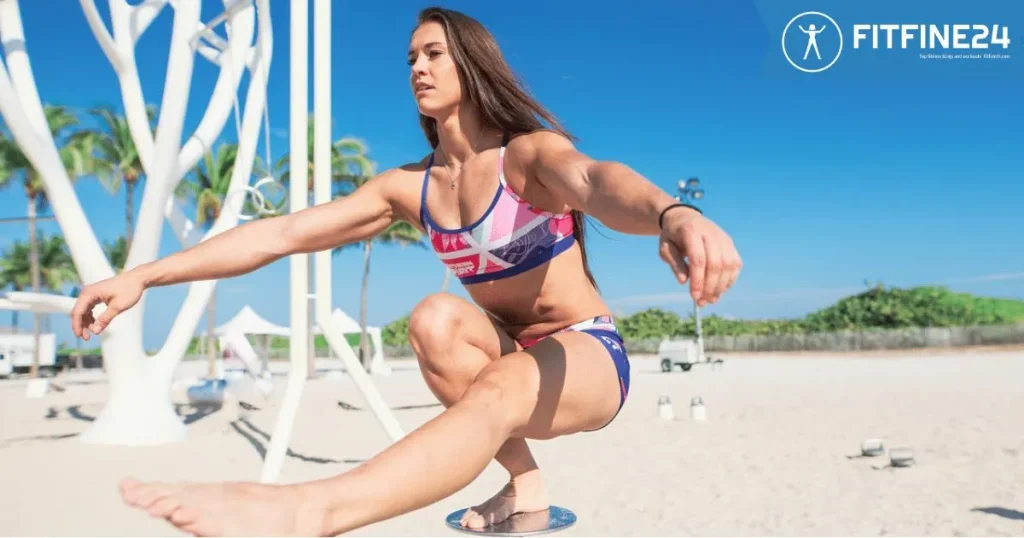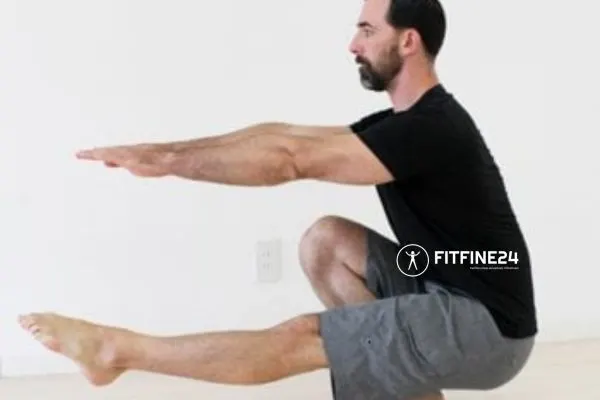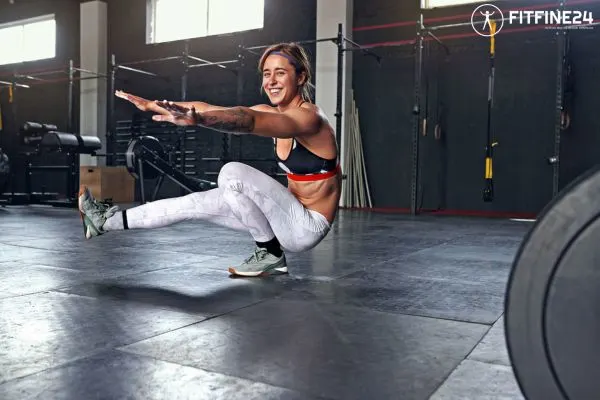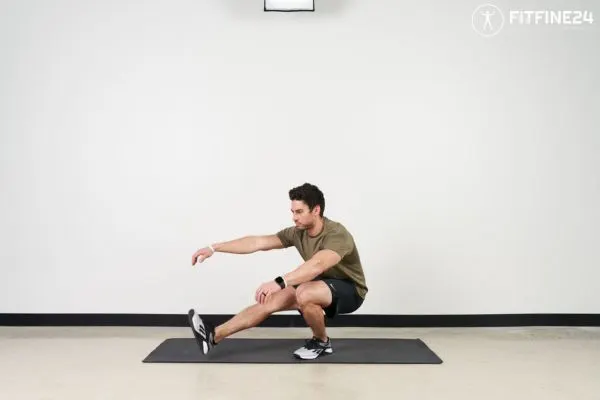
Welcome back to our site FitFine24, where you can find useful information about fitness and workout plans. Today, we are starting with one of the more complicated but equally efficient lower body exercises: the pistol squat.
This bodyweight workout not only assesses your endurance and balancing capacity but also improves the power and stability of the legs. In this guide, aimed at beginners and advanced athletes alike, we will discuss what pistol squats are, how they are done correctly, and how best to include them in a proper workout regime.
What Are Pistol Squats?
A pistol squat can be adequately described as a single-leg squat. You balance with one leg and squat down while expanding the other straight in front of you. Although not for beginners, this exercise requires strength, flexibility, balance, and coordination, amongst others. This is because it is effective in building parallel strength, which is instrumental in enhancing functional and sports performance.
Benefits of Pistol Squats

Increased Leg Strength: Among the many variations of squatting, the one-legged squats or pistol squats specifically affect the quadriceps, hamstrings, and glutes as the prime movers. This exercise builds severe muscle in the legs, which aids in better weight-bearing activities and performance of the lower body.
Enhanced Balance and Stability:
When you balance on one leg and do a squat rather than just doing a squat, your body’s stabilizing muscles are challenged, and your balance and core stability improve. This can lead to improvements in other exercises and other normal activities.
Improved Flexibility:
It helps and requires movement in the hips, knees, and ankles. The exercises can be performed in a deep squat position, which enhances flexibility in these joints, which is great for functional movement.
Functional Strength Development:
Pistol squatsare a great exercise because those movements are similar to the ones performed during many sports and activities. By performing this exercise, one can develop strength and balance, which will help improve performance in sports and decrease the risk of injuries.
Core Engagement:
More than that, a lot of core muscle activation is needed during performing this movement, which is how a pistol squat is also performed, to hold balance. This helps create better core stability, as the muscles from the abdominal and lower back are engaged.
How to Perform Pistol Squats Correctly:

Warm Up:
Make sure to begin with a general warm-up aiming for your muscles and joint preparation. Include dynamic stretching for the lower parts of the body like leg swings, downward lunges, and squats.
Find Your Balance:
You should stand with your feet shoulder-level distance apart. Lifting one leg and stretching it in front of the body, make sure it is inserted parallel to the floor. You can also stretch your other hand and hold onto a sturdy surface or a wall if required.
Initiate the Squat:
To initiate the squat, you can begin by slightly flexing the knee on the supporting legs and hip joints, moving the back towards the backplane. The person must fan the limbs out and lower himself slowly while making sure that the straightened leg does not touch the ground. For better understanding, the squat has to be as low an angle as possible while keeping the control and stability of the stretched frog’s body position.
Keep Your Chest Up:
Keep the chest upright even just before the motion is complete. Exert the torso muscles to keep the whole upper trunk free of movement so as not to sham along the forward direction.
Push Through Your Heel:

Push through the heel from the supporting leg and gradually increase the squat until the previous position is achieved. Smooth out the movement; all other than that shall be the same.
Repeat and Switch Legs:
Do the number of repetitions desired or needed to be completed on one leg before proceeding to the other leg. There is no need to emphasize too much on one side and too little on the other.
Common Mistakes to Avoid
Leaning Forward:
Bending forward. Chastizing. Do not bend or allow the chest to be forward-bent, in which it collapses in sinking, and let oneself in extreme breach forward. Expose the torso in the vertical, and the balance is assisted by the core, and forward lent is not allowed.
Knee Cave-In:
While squatting, do not allow your knee to fall inward. Your knee ought to be in line with your toes to avoid injury.
Inadequate Depth:
Experiment with the squat position only to the limit of your strength and flexibility. If you must do a squat, do a shallow one and do it correctly rather than deep squats in poor posture.
Relying on Momentum:
Spin the movement at a slow pace and do not use any momentum to exercise. Perform all parts of the movement very slowly to make the exercise most effective and minimize any chance of injury.
How do IPistol Squats into Your Fitness Routine?
Start with Progressions:
Beginners with little or no experience in pistol squats should always start with further progressions. They can use assisted pistol squats with a chair or other supports, or even assisted ones without any support.
Include in Lower-Body Workouts:

Pistol squats should not be left out of the lower body workout. Pair them with orders such as squats, lunges, deadlifts, or other compound movements for a full-leg training day.
Use as a Finisher:
Pistol squats should be included in your leg workouts as the most difficult super sets. They should be performed after other leg exercises in a set of leg exercises to overexert all the leg muscles.
Integrate with Mobility Work:
To help bulletproof yourself against overloading particular muscle groups, perform pistol squats followed by mobility workouts for the hips, knees, and ankles. Thus, you will advance your flexibility and range of motion, hence making the exercise more efficient.
Track Your Progress:
Keep track of the increments depending on how low you can squat as well as how many times you can do the squats. As you become stronger and more confident, try to progressively increase the intensity and volume.
Tips for Success
Focus on Form:
Do not concentrate on performing a certain number of repetitions on off days; instead, practice how you can correct the bad habits of incorrect squat techniques. Body movements are performed perfectly, and hence maximum benefits from performing this exercise.
Be Patient:
Pistol squats require patience as well as thorough practice to perfect them. Take it easy and concentrate on steadily getting better at it.
Listen to Your Body:
Concerning the movement, people’s responses should be task-driven rather than irritants. If some pain or abnormal feeling is experienced, the crush wants to change the body position and will or would seek help from the fat trainer.
Seek professional guidance:

In addition, if you are aware that your form is lacking or that you require more help than normal, then you should get a personal trainer or coach to whom you will be answering.
Conclusion
Pilates squats are a highly beneficial exercise that improves leg strength, balance, and flexibility. Even though these bodyweight exercises are difficult, the results merit them. If done properly and a little practice added, it can yield marvelous improvements in your fitness.
At FitFine24, we are more than happy to share our knowledge and workouts, all for the sake of helping you achieve your fitness goals. Do not wait any longer and begin adding pistol squats to your routine right now and enjoy the positive effects this complex exercise has on your body.

